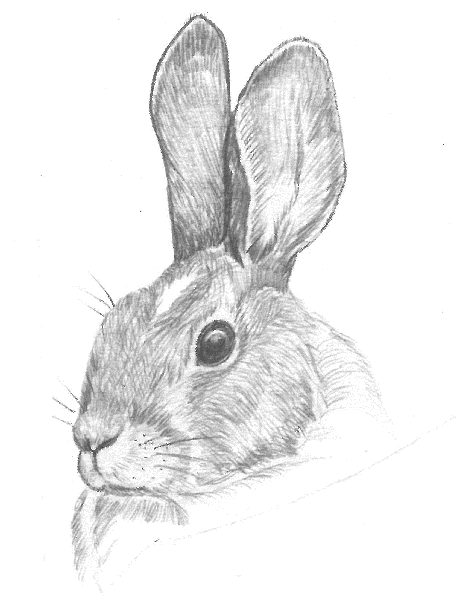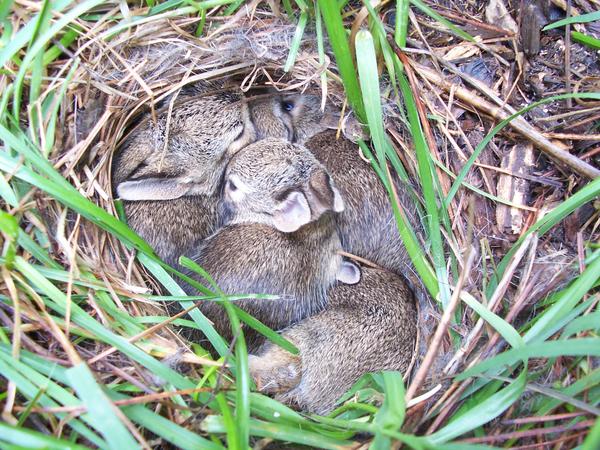Habitat Requirements
Cottontails live throughout the South from bottomlands and marshes to the highest mountain balds. They thrive in openings wherever shrubs, grasses, and forbs dominate. Eastern cottontails commonly occur in old homesites, abandoned orchards and agricultural fields, young forest, sumac and other shrubland patches, and brush piles. They adapt easily to live near humans and are common in urban areas.
Food
Common native rabbit foods:
- Wild rye
- Kentucky bluegrass
- Aster
- Blackberry
- New Jersey tea
- Gallberry
- Wild strawberry
- Phlox
- Sumac
- Sassafrass
Cover
Eastern cottontails use open forest with dense understory, young regenerating forest, and early successional vegetation with dense cover of shrubs, brambles, and herbaceous vegetation. Dense low woody vegetation, briar patches, and brush piles are used for escape cover. Nests are usually in grass or forb cover. Interspersion of cover types, or small areas in close proximity, is ideal for rabbits.
Cottontails are a food source for many mammalian and avian predators, so cover that provides protection from predators is critical. Cottontails can generally withstand heavy predation if appropriate amounts of food and cover are present.
Eastern cottontails typically nest during the spring and summer. Nests are dug in the ground and lined with grass and loose fur. Nests are relatively small, about 4" across and 4" deep. The female rabbit, or doe, typically has 2 or 3 litters per season with 3-8 rabbits per litter. After brooding, the nest is abandoned.
Water
Succulent plants and dew provide the daily requirements for water. Although open drinking water may be readily used, it is not a necessary element of eastern cottontail habitat.
Home Range
The home range of female eastern cottontails varies from 8 acres during breeding season to 5 acres in non-breeding season. Adult male home ranges vary from 15 acres or more during the breeding season to <10 acres during the non-breeding season.
Rabbit Management
Tips for Improving Rabbit Habitat
General
- Disperse small forest stands (10 to 20 acres) amongst fallow fields and bramble patches
- Thin forest stands frequently to lower canopy cover (<50%) and stimulate understory growth
- Use prescribed burning to promote grasses and forbs, to prevent succession to tree cover, or to retain understory in open forests
- Keep pets (cats and dogs) confined especially during nesting periods
Direct improvements
- Maintain fallow fields and other openings and create brush piles along edges of fields, especially where escape cover is limited
- Disturb fallow fields every 2 to 3 years to maintain herbaceous foods and bramble thickets that provide cover, and consider alternating treatments that leave strips of herbaceous food and woody escape cover in close proximity
- Use disking or prescribed burning to maintain fallow fields more so than mowing, which creates a thatch at ground level that restricts rabbit movement and promotes dense grass cover
- Create "live" brush piles with hinge cutting (i.e., cutting the base of saplings halfway through and pushing over) or cutting smaller midstory trees entirely and leaving them on the ground (e.g., redcedars, holly)
- “Daylight“ forest roads by removing trees along road edges to stimulate herbaceous plants, brambles, and low woody vegetation along roadsides

Fell small trees, especially evergreens like eastern redcedar, and leave them laying as cover for cottontails. Cutting the trees also allows more sunlight to the ground where rabbits live.
Chris Moorman CC BY-NC 4.0
Species That Benefit From Rabbit Management
Numerous game and nongame species benefit from rabbit management practices. Management plans should emphasize the communities that are associated with rabbits, rather than rabbits alone. The following species are common rabbit associates:
- Northern bobwhite (quail)
- Field sparrow
- White-tailed deer
- Red-tailed hawk
- Gray fox
- Eastern meadowlark
- Yellow-breasted chat
- Indigo bunting
- Black rat snake
- Cotton rat
- Red fox
Working With Wildlife
North Carolina State University Extension - Forestry
Working With Wildlife Series
Publication date: Feb. 27, 2019
Reviewed/Revised: Dec. 4, 2024
N.C. Cooperative Extension prohibits discrimination and harassment regardless of age, color, disability, family and marital status, gender identity, national origin, political beliefs, race, religion, sex (including pregnancy), sexual orientation and veteran status.
N.C. Cooperative Extension prohibits discrimination and harassment regardless of age, color, disability, family and marital status, gender identity, national origin, political beliefs, race, religion, sex (including pregnancy), sexual orientation and veteran status.


